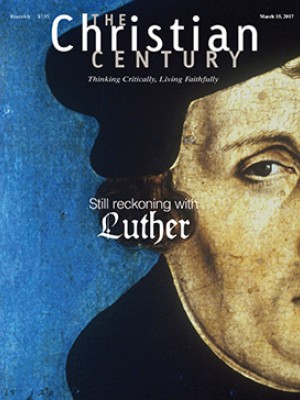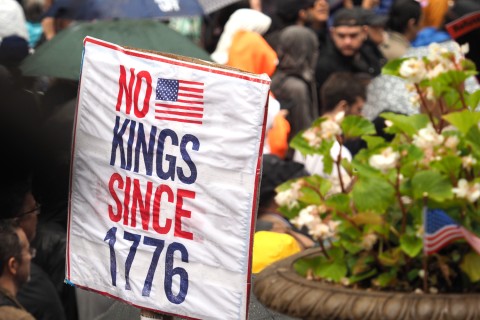Read the author's column on the liturgy of the Passion.
As Jesus enters Jerusalem, he engages in one of the most effective forms of protest: taking well-understood symbols and reappropriating them.
First, Jesus appropriates the symbols of the king. As he and his disciples draw near to the holy city, Jesus instructs his disciples to procure two beasts—a donkey and a colt—in fulfillment of Zechariah 9:9:
Tell the daughter of Zion,
look, your king is coming to you,
humble, and mounted on a donkey,
and on a colt, the foal of a donkey.
The disciples honor Jesus’ request, and they lay their cloaks on the animals’ backs for his throne. Soon the people are throwing their own cloaks on the road in front of Jesus, along with branches torn from nearby trees, paving a royal path before him.
But unlike corrupt and egocentric political rulers, this king’s mission, according to the prophet, is to restore Jerusalem and rescue Israel from its oppressors. Notice how this king enters: not flaunting power or threatening violence, but in humility and peace. In sharp contrast to King Herod’s warhorses, Jesus’ mounts are a donkey and a colt. Like Solomon entering Jerusalem on a mule (1 Kings 1:33), Jesus comes in peace; he comes not to magnify his own ego, but to fulfill God’s agenda.
Read our latest issue or browse back issues.
And in contrast to Herod’s armed soldiers and fawning sycophants, Jesus’ retinue is a crowd of common people—people seeking hope and justice, people longing for freedom from foreign oppression. Eventually, he will indeed be crowned by mocking soldiers (Matt. 27:27–29), and his cross will bear the motif, “King of the Jews” (27:37).
Second, Jesus appropriates the symbols of priest, the one who comes to restore faithful life and pure worship. The crowds have made Jesus’ entry into what the psalmist calls a “festal procession,” complete with shouts of “Hosanna,” “Save us,” and “Blessed is the one who comes in the name of the Lord!” They are preparing the way for Jesus to enter the Temple, to come to the horns of the altar.
But Jesus does not come merely to make an offering or lift incense to the Lord. Instead, after arriving in Jerusalem, his first act is to cleanse the Temple, driving out merchants and money-changers—and welcoming instead the unclean, healing the blind and lame (21:12–14). Ultimately, Jesus himself will be anointed with incense (26:6–13) and sacrificed on the cross.
Third, Jesus appropriates the symbols of the prophet, as identified by the crowds around him. By the time Jesus enters Jerusalem, the town is in an uproar—a shaking (eseisthe), like the earthquake that strikes days later as Jesus dies (27:51). But even as the city explodes in chaos, the crowds do not really know whom they are greeting or what his full agenda is. As the city asks, “Who is this?” the crowds respond, “This is the prophet Jesus from Nazareth in Galilee.”
Earlier Jesus warned his followers of the dangers of false prophets—those who come in sheep’s clothing but are ravenous as wolves. “By their fruit you shall know them,” he said (7:15–20). Soon he will evoke that prediction when he curses the barren fig tree at the side of the road (21:18–22). Soon he will show the people exactly how rancid the fruit of the establishment’s religious leaders is, how they have substituted their own words for the true word of God, in service to their power and self-gratifying piety (23:1f.). In the end, Jesus will prove to be the truest prophet of them all, the one who carries God’s living Word in his own flesh and blood.
All of which leads me to wonder: as we enter Palm Sunday this year, instead of a sweet children’s parade, with adorable little ones swinging palms and shouting “Hallelujah,” what if we treated this day as the protest it really was?
What if we followed Jesus’ kingly example, questioning political rulers who throw their weight around and guard themselves with handlers? What if we created a royal pathway for the humble instead, lifting up the need for fair treatment and equal rule for all? What if we used this day to appeal to our legislators for justice?
What if we followed Jesus’ priestly lead and used this time to question the point of our worship? What if, instead of collecting an offering for our church’s use that day, we went out into the soup kitchens and raised up a fragrant offering for the hungry? What if we took our voices in song to the homebound, or sat down to break bread at table with refugees—not as a token, but as a step toward holy community?
What if we followed Jesus’ prophetic voice and called ourselves on our own well-intentioned hypocrisy? God knows the way our time and priorities get caught up in fund-raising, committee meetings, building upkeep, and institutional preservation. What if we took this day to look—really look—at the fruits of our church’s life together? What if we measured our well-being not in terms of numbers but in terms of faithfulness to the Gospel?
Palm Sunday started out not as a parade, but as a protest. How exciting it would be to honor Jesus’ courage with a reboot of this start to Holy Week. There is plenty in our country and our congregations to question right now. I would love to know how this might play out in our own Jerusalems.






